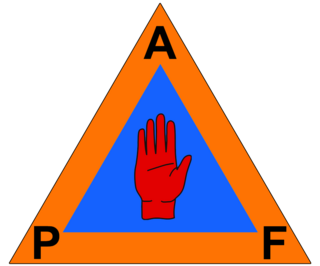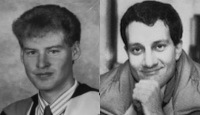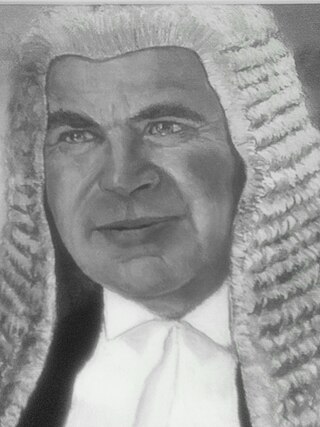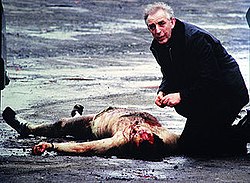
The Ulster Volunteer Force (UVF) is an Ulster loyalist paramilitary group based in Northern Ireland. Formed in 1965, it first emerged in 1966. Its first leader was Gusty Spence, a former British Army soldier from Northern Ireland. The group undertook an armed campaign of almost thirty years during The Troubles. It declared a ceasefire in 1994 and officially ended its campaign in 2007, although some of its members have continued to engage in violence and criminal activities. The group is a proscribed organisation and is on the terrorist organisation list of the United Kingdom.

Operation Flavius was a military operation in which three members of the Provisional Irish Republican Army (IRA) were controversially shot dead by the British Special Air Service (SAS) in Gibraltar on 6 March 1988. The trio were believed to be planning a car bomb attack on British military personnel in Gibraltar. They were shot dead while leaving the territory, having parked a car. All three were found to be unarmed, and no bomb was discovered in the car, leading to accusations that the British government had conspired to murder them. An inquest in Gibraltar ruled that the authorities had acted lawfully but the European Court of Human Rights held that, although there had been no conspiracy, the planning and control of the operation was so flawed as to make the use of lethal force almost inevitable. The deaths were the first in a chain of violent events in a fourteen-day period. On 16 March, the funeral of the three IRA members was attacked, leaving three mourners dead. At the funeral of one, two British soldiers were killed after driving into the procession in error.

The Milltown Cemetery attack took place on 16 March 1988 at Milltown Cemetery in Belfast, Northern Ireland. During the large funeral of three Provisional IRA members killed in Gibraltar, an Ulster Defence Association (UDA) member, Michael Stone, attacked the mourners with hand grenades and pistols. He had learned there would be no police or armed IRA members at the cemetery. As Stone then ran towards the nearby motorway, a large crowd chased him and he continued shooting and throwing grenades. Some of the crowd caught Stone and beat him, but he was rescued by the police and arrested. Three people were killed and more than 60 wounded. The "unprecedented, one-man attack" was filmed by television news crews and caused shock around the world.
The Kingsmill massacre was a mass shooting that took place on 5 January 1976 near the village of Whitecross in south County Armagh, Northern Ireland. Gunmen stopped a minibus carrying eleven Protestant workmen, lined them up alongside it and shot them. Only one victim survived, despite having been shot 18 times. A Catholic man on the minibus was allowed to go free. A group calling itself the South Armagh Republican Action Force claimed responsibility. It said the shooting was retaliation for a string of attacks on Catholic civilians in the area by Loyalists, particularly the killing of six Catholics the night before. The Kingsmill massacre was the climax of a string of tit-for-tat killings in the area during the mid-1970s, and was one of the deadliest mass shootings of the Troubles.

Mairéad Farrell was a member of the Provisional Irish Republican Army (IRA). She was shot and killed by the British Army in Gibraltar on 6 March 1988.

The Shankill Road bombing was carried out by the Provisional Irish Republican Army (IRA) on 23 October 1993 and is one of the most well-known incidents of the Troubles in Northern Ireland. The IRA aimed to assassinate the leadership of the loyalist Ulster Defence Association (UDA), supposedly attending a meeting above Frizzell's fish shop on the Shankill Road, Belfast. Two IRA members disguised as deliverymen entered the shop carrying a bomb, which detonated prematurely. Ten people were killed: one of the IRA bombers, a UDA member and eight Protestant civilians, two of whom were children. More than fifty people were wounded. The targeted office was empty at the time of the bombing, but the IRA had allegedly realised that the tightly packed area below would inevitably cause "collateral damage" of civilian casualties and continued regardless. However, the IRA have denied this saying that they intended to evacuate the civilians before the explosion. It is alleged, and unearthed MI5 documents appear to prove, that British intelligence failed to act on a tip off about the bombing.
Seán Savage was a member of the Provisional IRA who was shot dead by the British Army whilst being accused attempting to plant a car bomb in Gibraltar.

The Protestant Action Force (PAF) was a front group used by Ulster loyalist paramilitaries in Northern Ireland when claiming responsibility for a number of attacks during the Troubles. First used in 1974, attacks by individuals claiming to be members of the PAF killed at least 41 Catholic civilians. The PAF was most commonly used by members of the Ulster Volunteer Force (UVF). All of the attacks claimed by the PAF in Armagh and Tyrone counties from 1974 to 1976 have been linked to the Glenanne gang, which was a group consisting of members of the UVF Mid-Ulster Brigade along with rogue Ulster Defence Regiment (UDR) soldiers and Royal Ulster Constabulary (RUC) police officers. A six-year period of no attacks claimed by the PAF ended in 1982; during the 1980s, the PAF claimed 15 attacks in the Belfast area and two in County Armagh. UDR soldiers were convicted of two attacks in Armagh. The PAF claimed its last attacks in the early 1990s, all of which were in north Armagh and were alleged to involve members of the security forces.
Events during the year 1988 in Northern Ireland.
The McMahon killings or the McMahon murders occurred on 24 March 1922 when six Catholic civilians were shot dead at the home of the McMahon family in Belfast, Northern Ireland. A group of police officers broke into their house at night and shot all eight males inside, in an apparent sectarian attack. The victims were businessman Owen McMahon, four of his sons, and one of his employees. Two others were shot but survived, and a female family member was assaulted. The survivors said most of the gunmen wore police uniform and it is suspected they were members of the Ulster Special Constabulary (USC). It is believed to have been a reprisal for the Irish Republican Army's (IRA) killing of two policemen on May Street, Belfast the day before.
This is a chronology of activities by the Provisional Irish Republican Army (IRA) from 1980 to 1989. For actions before and after this period see Chronology of Provisional Irish Republican Army actions.

The 1971 Scottish soldiers' killings took place in Northern Ireland during The Troubles. On 10 March 1971, the Provisional Irish Republican Army (IRA) shot dead three off-duty British soldiers of the 1st Battalion, Royal Highland Fusiliers. The soldiers were from Scotland and two were teenage brothers. They were lured from a pub in Belfast where they had been drinking, driven to a remote location and shot by the roadside. Three British soldiers had been killed before this, but all had been killed during rioting.

Nick Spanos and Stephen Melrose were Australian tourists shot dead in Roermond, the Netherlands by the Provisional Irish Republican Army (IRA) on 27 May 1990, which stated it had mistaken them for off-duty British soldiers. The attack was part of an IRA campaign in Continental Europe.

On 15 June 1988 an unmarked military van carrying six British Army soldiers was blown up by the Provisional Irish Republican Army (IRA) at Market Place in Lisburn, Northern Ireland. The explosion took place at the end of a charity marathon run in which the soldiers had participated. All six soldiers were killed in the attack – four outright, one on his way to hospital and another later on in hospital.
The Special Reconnaissance Unit, also known as the 14 Field Security and Intelligence Company was a part of the British Army Intelligence Corps involved in plainclothes operations in Northern Ireland from the 1970s onwards.

Ronald Appleton, is the former chief crown prosecutor for Northern Ireland, a post he held for 22 years, a period that spanned the Northern Ireland 'Troubles'. Having established a broad civil practice as a QC he became one of the most experienced terrorism trial lawyers in the UK. As senior counsel he led for the Crown in many of the major murder and terrorism cases during those years. Martin Dillon, in his book on the Shankill Butchers trial described Ronald Appleton as "one of the outstanding lawyers of his generation".
The Provisional IRA carried out two separate attacks on the same day on 1 May 1988 against British military personnel in the Netherlands which resulted in the deaths of three RAF members and another three being injured. It was the worst attack suffered by the British security forces during The Troubles from 1969 to 1998 in mainland Europe.
On 28 March 1991 a member of the Ulster Volunteer Force (UVF), a loyalist paramilitary group, shot dead three Catholic civilians at a mobile shop in Craigavon, County Armagh, Northern Ireland. The gunman boarded the van and shot two teenage girls working there, then forced a male customer to lie on the pavement and shot him also. The killings were claimed by the "Protestant Action Force", who alleged the mobile shop was owned by an Irish republican. Staff said they had been harassed by Ulster Defence Regiment (UDR) soldiers for not serving them.
The following is a Timeline of British Army and Royal Ulster Constabulary (RUC) undercover operations during Operation Banner during the 1969 – 1998 Northern Irish conflict in Northern Ireland that resulted in death or injury. Including operations by the SAS, 14 Intelligence Company, the Military Reaction Force (MRF), RUC Special Patrol Group and Special Branch.
The Stag Inn attack was a sectarian gun attack, on 30 July 1976, carried out by a group of Belfast IRA Volunteers using the cover name Republican Action Force. Four Protestants, all civilians, the youngest being 48 years old and the eldest 70, were all killed in the attack with several others being injured. Three Catholics were killed the previous day in a Loyalish bomb, part of a string of sectarian attacks in Northern Ireland by different paramilitary organizations.










